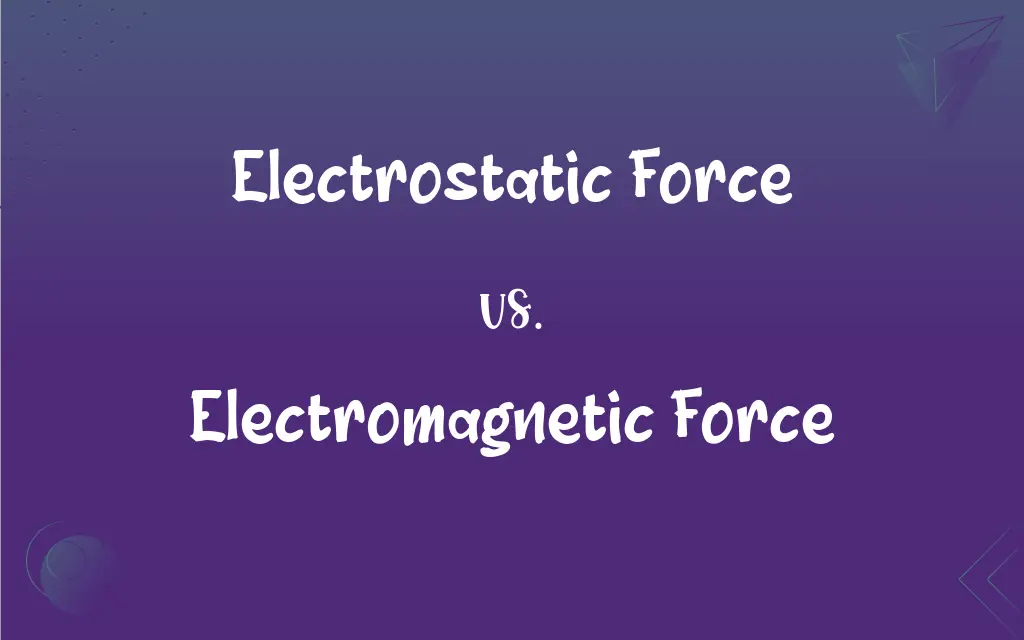Electrostatic Force vs. Electromagnetic Force: What's the Difference?
Edited by Aimie Carlson || By Harlon Moss || Published on September 3, 2024
Electrostatic force is the force between static electric charges, while electromagnetic force includes both electric and magnetic fields in motion.

Key Differences
Electrostatic force arises from static electric charges either attracting or repelling each other. This force operates according to Coulomb's law, which quantifies the magnitude of the force between two point charges. Electromagnetic force encompasses both electric forces and magnetic forces. It is described by Maxwell's equations, which unify electricity, magnetism, and light into a single theoretical framework.
The electrostatic force is crucial in explaining phenomena like the attraction or repulsion between charged particles at rest. It plays a significant role in various fields, from material science to electrostatic applications like photocopiers and air filters. The electromagnetic force, on the other hand, explains not only the behavior of charged particles but also the interaction of these particles with magnetic fields. This force is responsible for almost all the forces we experience in daily life, excluding gravity.
Understanding the distinction between electrostatic and electromagnetic forces is fundamental in physics. While the electrostatic force is a key player in the static electrical phenomena, the electromagnetic force broadens this scope to include dynamic scenarios where charges are in motion, thereby encompassing a vast range of physical phenomena.
Comparison Chart
Nature of Charges
Involves stationary charges.
Involves both moving and stationary charges.
Forces Involved
Only electric forces are considered.
Both electric and magnetic forces are considered.
ADVERTISEMENT
Governing Laws
Governed by Coulomb's Law.
Described by Maxwell's Equations.
Phenomena
Primarily responsible for static electricity effects.
Governs a wide range of phenomena including light and electromagnetic waves.
Applications
Used in electrostatic precipitators, photocopiers.
Fundamental in motors, generators, wireless communication.
Electrostatic Force and Electromagnetic Force Definitions
Electrostatic Force
Electrostatic force can be either repulsive or attractive, depending on the charge types.
Similar charges repel, while opposite charges attract, illustrating the dual nature of electrostatic force.
Electromagnetic Force
Electromagnetic force encompasses forces due to electric charges, both at rest and in motion, and their induced magnetic fields.
An electric motor operates due to electromagnetic forces acting on current-carrying wires in a magnetic field.
ADVERTISEMENT
Electrostatic Force
Electrostatic force is the attraction or repulsion between stationary charged particles.
When you rub a balloon on your hair, it sticks to the wall due to electrostatic force.
Electromagnetic Force
Electromagnetic force is responsible for the interactions between charged particles and electromagnetic fields.
The auroras are a beautiful display of electromagnetic forces as charged particles from the sun interact with Earth's magnetic field.
Electrostatic Force
The magnitude of the electrostatic force decreases with the square of the distance between charges.
As two charged objects are moved farther apart, the electrostatic force between them weakens noticeably.
Electromagnetic Force
Electromagnetic force governs the chemical bonds between atoms, making it crucial for chemistry and biology.
The bond between hydrogen and oxygen atoms in water molecules is due to electromagnetic forces.
Electrostatic Force
Electrostatic force operates through the vacuum or air without needing a physical medium.
Lightning is a dramatic demonstration of electrostatic force acting through the air.
Electromagnetic Force
Electromagnetic force is fundamental to the propagation of light and other electromagnetic waves.
Radio waves transmitting music to your radio are a form of electromagnetic force at work.
Electrostatic Force
Electrostatic force is a conservative force; the work done in moving a charge between two points is path-independent.
The work done to move a charged particle in an electric field depends only on its starting and ending points, a characteristic of electrostatic force.
Electromagnetic Force
Electromagnetic force includes the effects of electromagnetism, where electric currents produce magnetic fields.
A current-carrying coil behaves as a magnet, demonstrating the electromagnetic force in action.
FAQs
What is electrostatic force?
It's the force between stationary electric charges, either attracting or repelling them based on their charges.
What is an example of electrostatic force in everyday life?
Static cling of clothes is a common example of electrostatic force.
How does distance affect electrostatic force?
Electrostatic force decreases with the square of the distance between charges.
Can electromagnetic force be shielded?
Yes, electromagnetic forces can be shielded by materials like Faraday cages.
How does electrostatic force differ from gravitational force?
Electrostatic force can be attractive or repulsive, while gravitational force is always attractive.
How does electromagnetic force influence daily technology?
It's crucial for the functioning of devices like smartphones, computers, and MRI machines.
What role does electromagnetic force play in chemistry?
It's fundamental in forming chemical bonds between atoms.
What are Maxwell's Equations?
They are a set of equations that describe how electric and magnetic fields are generated and altered by each other and by charges and currents.
Can electrostatic force act through a vacuum?
Yes, electrostatic force can act through a vacuum, as it does not require a medium.
What is Coulomb's Law?
It describes the electrostatic force between two point charges.
How do magnets relate to electromagnetic force?
Magnets produce magnetic fields, which are an aspect of electromagnetic force.
What is electromagnetic force?
It's a fundamental force including both electric and magnetic interactions between charged particles.
How does the speed of charged particles affect electromagnetic force?
Faster moving charges produce stronger magnetic fields, influencing the electromagnetic force.
How does electrostatic force contribute to air filtration?
Electrostatic precipitators use electrostatic force to remove particles from exhaust gases.
How do electric and magnetic components of electromagnetic force relate?
Moving electric charges create magnetic fields, linking electric and magnetic forces.
How does the electromagnetic force relate to the speed of light?
The speed of electromagnetic waves in a vacuum is the speed of light, linking light to electromagnetic force.
Can electromagnetic force affect non-metallic objects?
Yes, it can induce polarization in insulators and affect charged particles in them.
What is the significance of electromagnetic waves?
They are a form of electromagnetic force carrying energy across space, essential for communication and radar.
What are the applications of electrostatic force in manufacturing?
It's used in processes like powder coating and inkjet printing for precise placement of materials.
Is electrostatic force a part of electromagnetic force?
Yes, electrostatic force is a specific case of electromagnetic force with stationary charges.
About Author
Written by
Harlon MossHarlon is a seasoned quality moderator and accomplished content writer for Difference Wiki. An alumnus of the prestigious University of California, he earned his degree in Computer Science. Leveraging his academic background, Harlon brings a meticulous and informed perspective to his work, ensuring content accuracy and excellence.
Edited by
Aimie CarlsonAimie Carlson, holding a master's degree in English literature, is a fervent English language enthusiast. She lends her writing talents to Difference Wiki, a prominent website that specializes in comparisons, offering readers insightful analyses that both captivate and inform.






































































